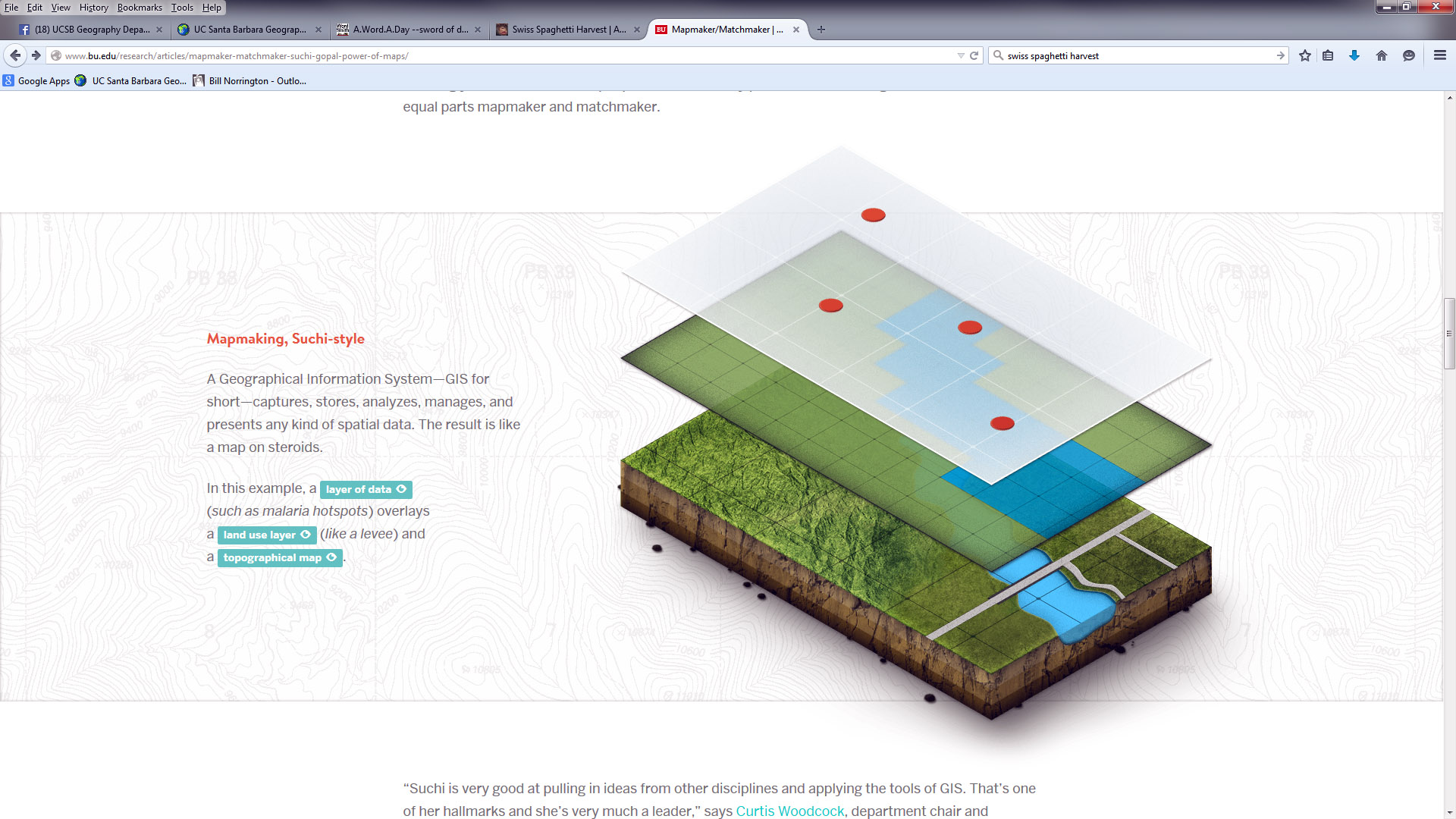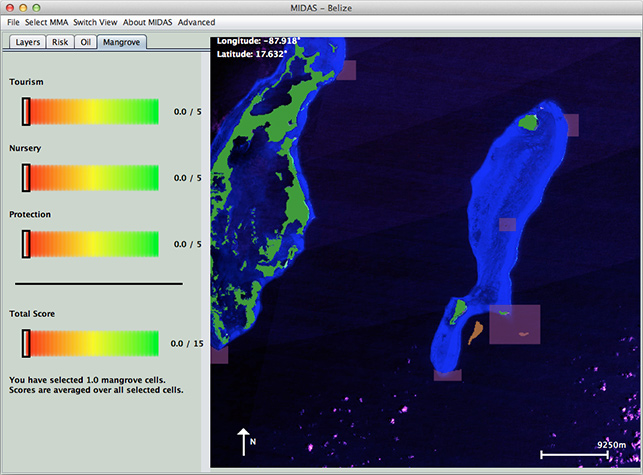The following is a Boston University research article written by Barbara Moran and with the title above:
Suchi Gopal bursts into her classroom, buzzing with energy. The 11 graduate students parked behind glowing computer monitors rouse themselves from reverie. It’s late in the semester and they are preoccupied with their final projects. But Gopal has more to teach. “Aha!” she claps with delight. “Today we will do some math!”
She grabs a piece of chalk and draws a grid on the blackboard, then fills in numbers: temperature data from points across the United States. Gopal, a professor in Boston University’s earth and environment department, is a renowned expert (and devoted teacher) in the field of geographic information systems (GIS). It’s what laypeople might call “making maps with computers.” And, as Gopal teaches, maps are power. A long list of statistics on bicycle accidents at BU, for instance, is just an inscrutable jumble of numbers. But insert the data into GIS, overlay a map of campus, and the computer builds a map that makes the data instantly understandable. In that case, it becomes clear that most bike accidents don’t occur at intersections, as one might expect, but when the bike lane veers too close to parked cars and bicyclists get doored. Maps provide a deeper understanding of a problem, so people can choose the right solutions.
Over the past two decades, as computing power has increased, GIS has risen from an obscure tool for measuring Canadian farms to a powerful technique that maps everything from the eating patterns of orangutans to health care access in Zambia. And Gopal, with her expertise in statistics and geography, as well as her wide-ranging scientific interests, rides the tip of this trend. Gopal’s students in Introduction to GIS come from public health, social work, geography, neuroscience, anthropology, and myriad other fields to learn how to turn their dry data into spectacular maps. Today, Gopal is teaching them the power of computing by snatching it away.
“Who wants to go to the board and work out the math? C’mon, I’ll help you!” Smiling, cajoling, Gopal encourages two students to the board, where they begin to solve a series of tedious equations, usually crunched by computer. Finally, the students find an answer: 29.374. Gopal circles it in blue chalk. “This is the temperature of just one unknown location,” she says. “You see how much work that was? On the computer, everything is so sweet and quick.”
The exercise is Gopal’s work in a nutshell: years of research, thousands of data points, millions of calculations, all painstakingly collected, entered, checked, and finally hidden behind a beautiful, brightly colored map that anyone can understand intuitively. But Gopal’s talent goes far beyond the science of data crunching. She is gifted in the unteachable art of weaving: bringing together seemingly unrelated ideas and people to attack thorny problems. Her colleagues describe her as equal parts mapmaker and matchmaker.
“Suchi is very good at pulling in ideas from other disciplines and applying the tools of GIS. That’s one of her hallmarks and she’s very much a leader,” says Curtis Woodcock, department chair and professor of earth and environment. “Suchi is one of the more freewheeling, quick-thinking, fast-associating people I know. The ideas just bounce out of her.”
“A map is a means of communication,” says Gopal, “and it is not the God-given truth. It’s the way you design it. The mapmaker makes the map.”
Sucharita Gopal—known universally as “Suchi”—grew up in Chennai, India. With two doctors for parents, dinner conversations “were all about illness and sickness and health and wellness,” says Gopal. “That’s where the curiosity came from.” In college, Gopal became entranced with the idea of how people move through their landscape, and the power of maps to help people understand how to make decisions, including choices about public health. “Everything happens in space,” she says. “Health happens in space.” She left India in 1983 for the University of California, Santa Barbara (UCSB), to pursue her PhD in geography.
UCSB was—and still is—a leader in GIS. Computerized mapping had sprung up in the early 1960s, as large mainframe computers became more widely available. The US Census Bureau wanted better maps, as did military spies, British botanists, and urban planners. But it was an English geographer named Roger Tomlinson who became widely known as the “father of GIS” for persuading the Canadian government to create the Canada Geographic Information System (CGIS) in 1966 to conduct a massive inventory of the country’s land. Their goal: to see how much land was farmed and which farms were productive. They operated the system until the late 1980s.
When Gopal arrived at UCSB, commercial GIS systems were entering academia, but many scientists didn’t know what to do with them. “Through the ’80s, there were just a few people around the world who recognized the significance of GIS,” says Michael Goodchild, a professor emeritus from UCSB who advised Gopal on her thesis. “We had the president of the Association of American Geographers on record as saying that GIS was a nonintellectual expertise.”
Suchi Gopal held no such notions. Even then, she saw potential uses for maps in many fields. She also understood their power. A map is only useful, she says, if someone is using her brain to make it, and analyzing the data honestly. “Maps can lie,” says Gopal. “Hitler lied to the German people by exaggerating the threat from Britain and France. A map is a means of communication, and it is not the God-given truth. It’s the way you design it. The mapmaker makes the map.”
After finishing her PhD [1988], Gopal joined BU’s geography department in 1989 and soon embarked on an unusual collaboration with neural modeler Gail Carpenter, who was studying pattern recognition. Gopal had done related work at UCSB, building an artificial intelligence model to study how people use patterns and landmarks to navigate through space. The geographer and the neuroscientist thought their combined understanding of brains and mapping might help solve a growing problem: data overload. “Back then, everyone was already saying that they were overwhelmed by data,” says Carpenter. “It’s nothing like it is today, but even then people were already overwhelmed.”
Gopal and Carpenter were looking at a particular set of data: thousands upon thousands of ground images from Landsat satellites. It was a classic case of Too Much Information: the photos were great, but it took humans months—if not years—to analyze them. The scientists wanted to make the satellites more like people: choosier about the data they collect. “One of the things that makes us different from satellites is how we pay attention,” says Carpenter. “We know what to ignore.” Take driving, for instance. “You don’t notice every single tree, but you notice the fire truck coming,” says Carpenter. “We filter out the unimportant stuff. That’s how we handle lots of data with a pretty narrow bandwidth.”
Could satellites be taught to do the same? Carpenter and Gopal developed a computer learning system—a series of algorithms that would allow a computer to look at Landsat images and discern mixtures of land cover, finding percentages of, say, wetland, conifer forest, and grass. Their system took minutes to churn through a photo that humans needed six months to analyze, with results of the same accuracy. “We developed methods that Suchi and her students still use all the time,” says Carpenter.
Gopal and Carpenter have remained friends and colleagues over the intervening decades, collaborating on research and lecturing in each other’s classes. “It takes a long time to establish interdisciplinary research, and she’s great at that,” says Carpenter. “But her best quality is generosity. Some people never learn the importance of being generous, but she just shines there.”
This generosity has given Gopal a web of connections stretching from her childhood pen pal in California (who she still keeps on speed dial) to scientists across disciplines and around the world. The range of her research is astonishing, and now it often loops back to the questions of health that originally drew her to geography. … “I want to solve real-world problems. I don’t want to write something that’s buried in a journal. I want to work with actual people to make a difference,” says Gopal. “All this data is only good if it addresses a societal problem.”
Editor’s note: Read the rest of the text here. Many thanks to Professor Emeritus Michael Goodchild for suggesting this material.





